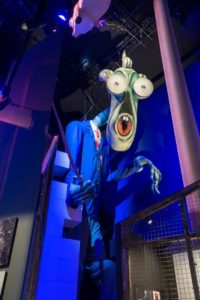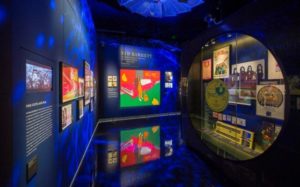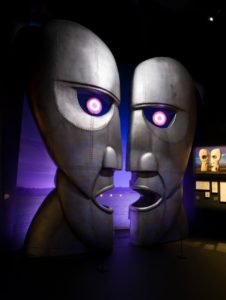Pink Floyd : Their Mortal Remains Exhibition, Review / Sneak Peak in Telegraph
 Pigs fly at the Victoria & Albert Museum, alongside sheep, replica warplanes, exploding fridges and UFOs, while a giant psychotic inflatable headmaster descends from the ceiling wielding his cane over a huge purple replica of Battersea Power Station. Like the band it celebrates, Their Mortal Remains certainly does not lack ambition.
Pigs fly at the Victoria & Albert Museum, alongside sheep, replica warplanes, exploding fridges and UFOs, while a giant psychotic inflatable headmaster descends from the ceiling wielding his cane over a huge purple replica of Battersea Power Station. Like the band it celebrates, Their Mortal Remains certainly does not lack ambition.
Visitors enter through a replica of a touring van, advance down a psychedelic rabbit hole of swirling op art and emerge into a dazzling space of hard reflective surfaces and audacious installations. Room after room is packed with a veritable treasure trove of artefacts and information about one of Britain’s most innovative and revered rock bands. You can walk through album sleeves, remix classic tracks, peer closely at lyric notebooks and vintage instruments, all the while listening to the band and their collaborators articulate the creative steps behind some of the most astonishing music and iconic imagery of the rock era.
Imaginatively conceived, fascinatingly curated, beautifully designed and stunningly realised, the Pink Floyd exhibition is something of an audio-visual tour de force for a museum that has become adept at putting pop culture in a highbrow gallery space. If, ultimately, it does not have the revelatory impact and intense personality of the V&A’s ground-breaking David Bowie Is exhibition in 2013, that is perhaps inherent in the nature of an oddly faceless band. As the joke used to go, “Which one’s Pink?”
There is an absence that haunted Floyd throughout their career, and haunts this exhibition too. Their 1975 masterpiece Wish You Were Here is evoked in a shiny, square, white space filled with images of the cryptic album sleeve. The warmth and beauty of the music itself plays second fiddle here to the contributions of Floyd collaborator Storm Thorgerson and his Hipgnosis design team.
 In a glass cabinet, however, you can find one small Polaroid of a plump, bald, unassuming fellow, which close examination reveals to be founding member Syd Barrett visiting Abbey Road Studio unannounced as the band recorded their spine-tingling tribute to him (and Wish You Were Here’s opening and closing track), Shine On You Crazy Diamond. Barrett was Floyd’s only real rock star, the maverick genius who set them off on their extraordinary trajectory, but whose contribution was cut short by psychosis (exacerbated by drug use). He is affectionately recalled on one wall display but, without him, the rest of the exhibition is beset by a peculiar lack of human focus.
In a glass cabinet, however, you can find one small Polaroid of a plump, bald, unassuming fellow, which close examination reveals to be founding member Syd Barrett visiting Abbey Road Studio unannounced as the band recorded their spine-tingling tribute to him (and Wish You Were Here’s opening and closing track), Shine On You Crazy Diamond. Barrett was Floyd’s only real rock star, the maverick genius who set them off on their extraordinary trajectory, but whose contribution was cut short by psychosis (exacerbated by drug use). He is affectionately recalled on one wall display but, without him, the rest of the exhibition is beset by a peculiar lack of human focus.
The core four piece line up from 1968-1985 (guitarist-vocalist David Gilmour, bassist-vocalist Roger Waters, keyboard player Rick Wright and drummer Nick Mason) were all middle-class, educated, intelligent, accomplished musicians. Their inventive use of sound technology, explorative approach to avant-garde musical ideas and astute incorporation of wider artistic, social, philosophical and theatrical concepts made them key figures in the psychedelic explosion (and its progressive rock offshoots), but they were not particularly psychedelic in themselves.
Interrogated on short, three-minute films accompanying each exhibit, they tend to be quite dry and dispassionate, creating a very cool and cerebral mood, with the madder and more enigmatic aspects of Floyd conjured by emphasising sleeve and stage designs.
 Also, it may be stating the obvious to say that music is vital to the Pink Floyd story, but this exhibition would be much diminished as a walking tour without the Bluetooth headphones bringing static installations to musical life. While it is a treat to walk through a darkened corridor illuminated by a holographic representation of the pyramid prism from Dark Side of the Moon, it is still the swirling keyboards and cosmic lead solo that really blow the mind.
Also, it may be stating the obvious to say that music is vital to the Pink Floyd story, but this exhibition would be much diminished as a walking tour without the Bluetooth headphones bringing static installations to musical life. While it is a treat to walk through a darkened corridor illuminated by a holographic representation of the pyramid prism from Dark Side of the Moon, it is still the swirling keyboards and cosmic lead solo that really blow the mind.
As it is, the exhibition fades off into empty spectacle towards the close, suffering much the same fate as Pink Floyd’s career. It is hard not to conclude that chief lyricist Roger Waters was right, and that Floyd should have ended when he left in 1985. The spikiest character in the band, Waters apparently insisted that Floyd’s remaining years as a touring and recording heritage act be kept separate, in this show, from their imperial Sixties and Seventies phase. But the result is three later rooms featuring recreations of overblown cover and stage designs that lack any intellectual rigour or artistic purpose, effectively a monument to a band who had by then become a monument to themselves.
There is, however, one final act of grace in a concert experience room at the very end, where you can see and hear the briefly reunited Pink Floyd’s valedictory performance of Comfortably Numb at Live8 in 2005, delivered in Sennheiser surround sound. It is absolutely gobsmacking, putting you right in the centre of one of the greatest pieces of music ever performed. Wish you were there? You will feel like you were.
